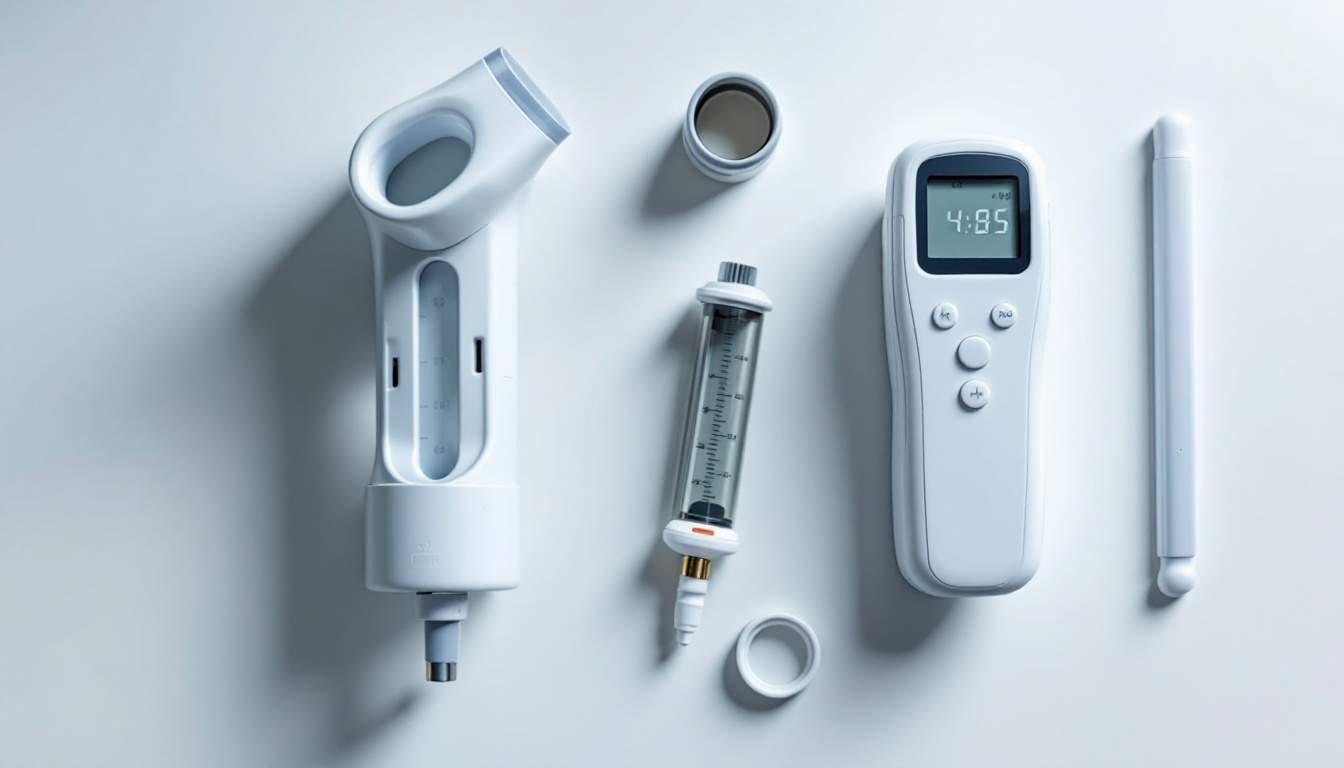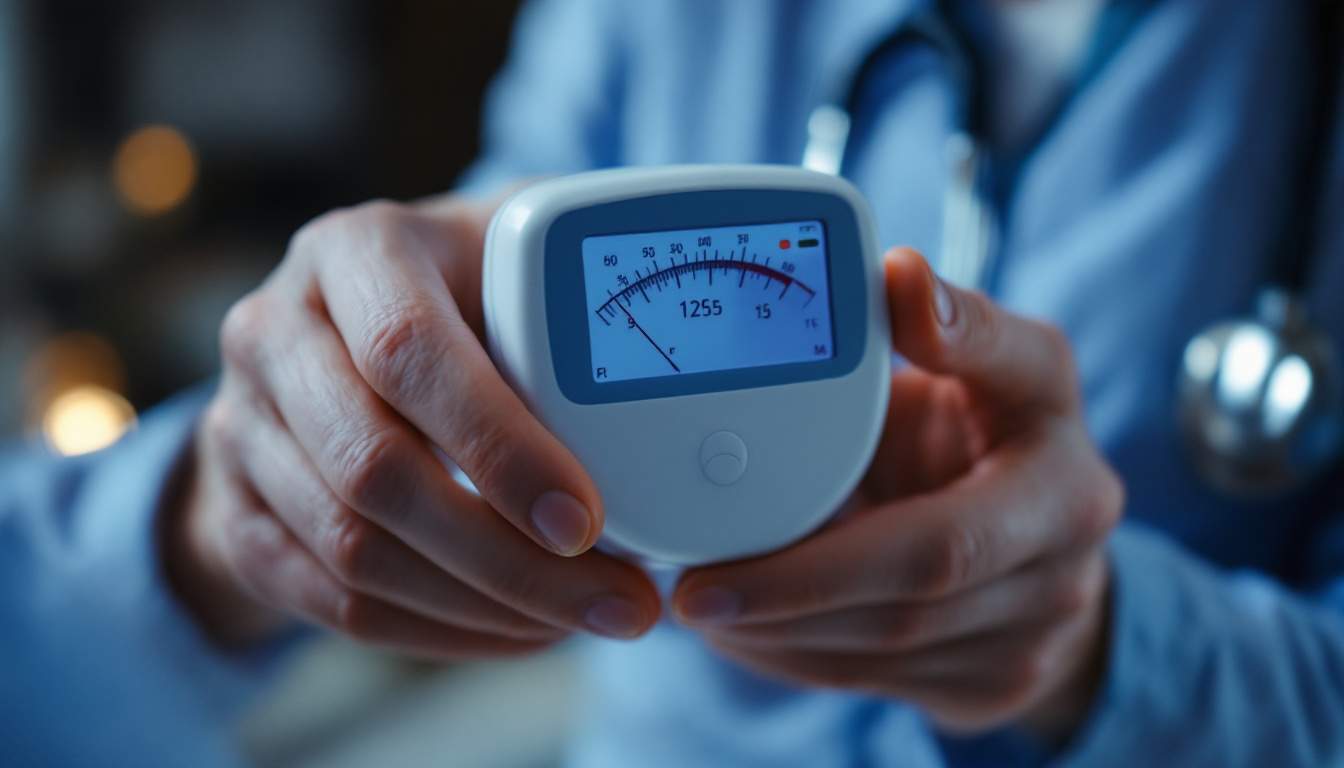Glossary: What is a Peak Flow Meter
In the realm of respiratory health, a peak flow meter serves as an invaluable tool for monitoring lung function, particularly for individuals managing asthma or other respiratory conditions. Understanding this device can empower patients and healthcare professionals alike, enabling better management of pulmonary health. This article provides an in-depth exploration of what a peak flow meter is, how it works, and its various components.
Understanding the Basics of a a Peak Flow Meter
A peak flow meter is a simple handheld device used to measure the peak expiratory flow rate (PEFR), which indicates how quickly air can be expelled from the lungs. Regular monitoring can help detect changes in lung function, allowing for timely interventions if necessary.
Definition of a Peak Flow Meter
Specifically, a peak flow meter provides a clear measurement of the maximum speed of exhalation. It utilizes a straightforward mechanism where the user exhales forcefully into the device, which then displays the result on a calibrated scale. This measurement is crucial for assessing the airway function and determining the severity of respiratory conditions. The device is typically lightweight and portable, making it easy for individuals to carry it with them and use it whenever necessary, whether at home, work, or school.
Importance of a Peak Flow Meter
The importance of a peak flow meter cannot be overstated, especially for those with asthma. By providing a quantifiable measure of lung function, patients can track their condition over time. Monitoring PEFR can help identify triggers, such as allergens or pollution, and indicate when an asthma action plan should be enacted.
Moreover, frequent monitoring helps patients recognize early warning signs of an asthma attack. This proactive approach can significantly reduce serious complications and improve overall quality of life. Additionally, using a peak flow meter can empower patients by involving them in their own care management. By understanding their personal best peak flow readings, individuals can make informed decisions about their health and communicate effectively with healthcare providers about their condition.
Furthermore, peak flow meters can be instrumental in educating patients and their families about asthma management. Many healthcare professionals recommend keeping a peak flow diary, where users can log their readings alongside symptoms and potential triggers. This not only fosters a deeper understanding of the disease but also encourages adherence to prescribed treatment plans, ultimately leading to better health outcomes. As patients become more attuned to their respiratory patterns, they can also develop strategies to minimize exposure to known triggers, thereby enhancing their overall well-being.
Components of a Peak Flow Meter
Understanding the key components of a peak flow meter can enhance its effectiveness. These devices are typically comprised of three main parts: the mouthpiece, the measurement scale, and the indicator. Each element plays a crucial role in accurate measurement and function.

The Mouthpiece
The mouthpiece is where the user exhales. It is designed to ensure a proper seal, allowing for an accurate measurement of airflow. Many mouthpieces come with a disposable cover for hygiene and ease of use. Additionally, some models feature ergonomic designs that enhance comfort during use, especially for children or those with sensitive gums. Regular cleaning and maintenance of the mouthpiece are essential to prevent the buildup of bacteria and ensure consistent performance over time.
The Measurement Scale
The measurement scale is printed on the side of the peak flow meter. It measures the peak expiratory flow in liters per minute (L/min). Depending on the design, the scale may vary, but professional-grade meters often have a broader range for more precise readings. Some advanced models even include color-coded zones that help users quickly identify their peak flow levels in relation to their personal best, facilitating better management of respiratory conditions. Understanding these zones can empower users to take proactive steps in their health management, such as adjusting medication or seeking medical advice when necessary.
The Indicator
The indicator is a movable part of the peak flow meter that slides along the measurement scale. After the user exhales into the device, the air pressure moves the indicator, stopping at the user's peak flow result. This visual representation makes it easy to read and interpret the output quickly. In more sophisticated models, the indicator may also feature a locking mechanism that allows users to record their highest reading without the risk of it resetting. This added functionality can be particularly beneficial for tracking progress over time, as users can maintain a log of their peak flow readings, which can be shared with healthcare providers for more informed treatment decisions.
How a Peak Flow Meter Works
The mechanics of a peak flow meter are straightforward but crucial for ensuring accurate results. Understanding how to use this device correctly can enhance the reliability of the readings and aid in effective asthma management.

The Role of Lung Capacity
Lung capacity plays a critical role in determining a person’s peak flow values. Each individual has a different peak flow based on a variety of factors, including age, height, and sex. Thus, knowing one’s personal best peak flow is essential for effective monitoring. Additionally, factors such as physical fitness and the presence of respiratory conditions can also influence lung capacity and, consequently, peak flow readings. Regular assessments can help individuals recognize changes in their lung function, which may signal the need for adjustments in their asthma management plan.
Reading and Interpreting Results
Once the indicator has stopped after an exhalation, the reading can be interpreted. Average peak flow values will differ by individual, but there are broad guidelines available. Users are encouraged to write down their daily results to identify trends over time, which can be particularly informative during flare-ups. This practice not only aids in personal monitoring but also provides valuable data for healthcare providers, enabling them to tailor treatment plans more effectively. Moreover, many patients find it beneficial to color-code their results based on their asthma action plan, helping them quickly ascertain if their peak flow is in the green, yellow, or red zone, indicating different levels of asthma control.
In addition to tracking daily readings, individuals can enhance their understanding of their asthma triggers by correlating peak flow results with environmental factors such as pollen counts, air quality, and even stress levels. This comprehensive approach allows for a more proactive stance in managing asthma, as patients can identify patterns and make necessary lifestyle adjustments. Furthermore, sharing this data with healthcare professionals can lead to more informed discussions about medication adjustments or the need for additional interventions, ultimately leading to better asthma control and improved quality of life.
Uses of a Peak Flow Meter
The use of a peak flow meter extends beyond mere measurement; it is integral to effective asthma management strategies. Patients can gain insights into their lung function on a day-to-day basis, realistically forecasting and mitigating potential crises. This proactive approach not only empowers patients but also fosters a deeper understanding of their condition, enabling them to recognize early warning signs and take appropriate action before an asthma attack occurs.
Monitoring Asthma
For individuals with asthma, regular monitoring is a critical component of effective disease management. A peak flow meter allows users to monitor their lung function daily, providing feedback that can inform medication use and lifestyle choices, thereby improving overall control of their condition. By establishing a personal best peak flow reading, patients can track fluctuations in their lung function, which can be influenced by various factors such as allergens, weather changes, and physical activity. This data can be invaluable for both patients and healthcare providers to tailor treatment plans that are responsive to individual needs.
Evaluating Lung Function
Healthcare professionals often use peak flow meters during assessments to evaluate lung function. By comparing a patient’s readings to expected norms, doctors can make informed decisions regarding treatment plans, whether that includes adjustments in medication or recommending further tests. Additionally, these readings can help identify patterns over time, such as seasonal variations in asthma symptoms or responses to specific triggers. This comprehensive evaluation not only aids in immediate treatment but also contributes to long-term management strategies, ensuring that patients can lead more active and fulfilling lives.
Enhancing Patient Education
Another significant use of peak flow meters is in enhancing patient education. By engaging patients in the monitoring process, healthcare providers can educate them about the importance of self-management in asthma care. This education can include training on how to properly use the meter, interpret the readings, and recognize when to seek medical attention. Furthermore, understanding how daily activities and environmental factors affect lung function can empower patients to make informed decisions about their health, such as avoiding known triggers or adhering to prescribed medication regimens.
Facilitating Communication with Healthcare Providers
Peak flow meters also serve as a vital communication tool between patients and their healthcare providers. Regularly recorded readings can be shared during appointments, providing a clear picture of the patient's condition over time. This data-driven approach allows for more productive discussions about treatment efficacy and potential adjustments. Moreover, in cases where patients experience exacerbations, having a record of peak flow readings can help clinicians quickly assess the situation and implement timely interventions, ultimately improving patient outcomes and reducing the risk of severe asthma attacks.
Benefits and Limitations of a Peak Flow Meter
Like any medical device, peak flow meters come with their own set of advantages and limitations. Understanding both sides can enhance patient compliance and optimize outcomes.
Advantages of Using a Peak Flow Meter
The significant benefit of using a peak flow meter is its ability to empower patients with knowledge about their condition. It is an accessible, portable, and inexpensive tool that anyone can use without extensive training. Additionally, it fosters communication between patients and healthcare providers by providing concrete data about lung function. This real-time data can help patients recognize early warning signs of an asthma attack, allowing them to take preemptive action, such as using a rescue inhaler or adjusting their medication. Moreover, regular monitoring can lead to better asthma control, reducing the frequency of emergency visits and hospitalizations, which can be both costly and distressing.
Potential Drawbacks
While peak flow meters are advantageous, they are not without their challenges. Users may struggle with inconsistent technique or fail to keep accurate records, leading to unreliable data. Furthermore, while peak flow meters can guide asthma management, they should not replace professional medical advice or treatment protocols. It's also worth noting that peak flow readings can be influenced by various factors, including the time of day, recent physical activity, and even the weather. This variability can sometimes lead to confusion or misinterpretation of the results, particularly for those who are new to using the device. Additionally, some patients may find it cumbersome to incorporate regular monitoring into their daily routines, potentially leading to lapses in usage that can diminish the effectiveness of the tool in managing their condition.
Proper Care and Maintenance of a Peak Flow Meter
To ensure accurate results and a long life for your peak flow meter, proper care and maintenance are essential. This includes regular cleaning and occasional checks for wear and tear.
Cleaning and Storage
Cleaning your peak flow meter is vital in maintaining its functionality. It is recommended to wash the mouthpiece regularly with warm, soapy water and allow it to air dry. Proper storage, such as placing it in a protective case when not in use, can also prevent damage. Additionally, it is advisable to keep the meter in a stable environment, away from extreme temperatures and humidity, which can affect its calibration and performance. For those who travel frequently, consider using a travel pouch that provides extra cushioning and protection against bumps and drops.
When to Replace Your Peak Flow Meter
Peak flow meters are durable devices; however, they may require replacement after several years of consistent use. Signs that it’s time for a new meter include difficulty reading results, signs of wear, or damage. Keeping a close eye on your device can ensure you remain aware of when to make necessary updates. Furthermore, if you notice that your readings fluctuate significantly without any changes in your health status, it may indicate that the device is no longer providing accurate measurements. Regularly comparing your readings with those from a healthcare professional's meter can also help in determining the reliability of your device.
Understanding the importance of calibration is another critical aspect of maintaining your peak flow meter. While many models are designed to be user-friendly, some may require periodic calibration to ensure that they provide precise measurements. This process can usually be performed by a healthcare provider or through specific instructions provided by the manufacturer. Keeping a log of your peak flow readings can also be beneficial, as it allows you to track trends over time and identify any potential issues with your meter or your respiratory health.
If you're interested in taking your respiratory health management to the next level, consider Alveo's innovative solution. Alveo is creating the world's first Continuous Respiratory Wearable, designed for everyday use to enhance your understanding of breathing patterns, the impact of environmental factors, and personalized breathing routines tailored to your lung capacity. With features like real-time monitoring, alerts, and the comfort of a light and unobtrusive device, Alveo is at the forefront of respiratory health technology. Don't miss out on the opportunity to be among the first to experience this groundbreaking wearable. Sign up on our waiting list today and breathe easier with Alveo.




